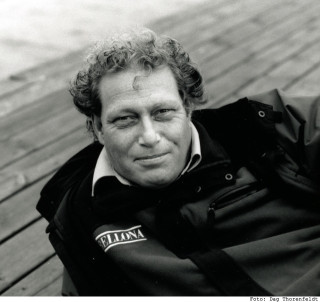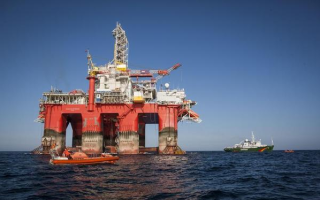
The system built to manage Russia’s nuclear legacy is crumbling, our new report shows
Our op-ed originally appeared in The Moscow Times. For more than three decades, Russia has been burdened with the remains of the Soviet ...
News

Publish date: August 8, 2014
News
Norwegian state oil company Statoil’s hopes were dashed as it failed to find commercially viable quantities of oil and gas in the northernmost wells the company has drilled before, casting a welcome shadow of doubt for environmentalists over the viability of Arctic hydrocarbon recovery.
“This is not an area where we should drill for oil, both from an environmental and economic cost perspective,” Frederic Hauge, Bellona’s president, told the Associated Press. “This is really wasted money from Statoil.”
Both Bellona and Greenpeace – the latter of which in spring boarded a Statoil rig in protest – greeted the failure of Statoil’s summer drilling forays into the Arctic warmly.
Offshore production in the area of the North Sea has been dropping off and environmental organizations like Bellona and Greenpeace fear drilling efforts in remote, icy areas could have catastrophic repercussions for pristine ecosystems in the event of a spill.

The Arctic is believed to contain close to a quarter of the world’s remaining oil and gas, according to a 2008 estimate by the US Geological Survey, accounting for the salivating of the world oil industry.
But, the eventuality of a spill, for Bellona’s Hauge, is not a question of “if” but rather “when,” he has said.
Greenpeace Norway told UPI that Statoil should never have been allowed to drill in the Barents area in the first place.
“The licenses should never have been awarded in the first place,” Greenpeace Norway’s director Truls Gulowsen
said in a statement to UPI Thursday. “When all these wells turned up uncommercial, it is safe to say the birds at Bear Island were victorious.”
Statoil’s failed test wells
Statoil had had high hopes for the Hoop area after oil was discovered just 20 kilometers away last year.
But, out of three exploration wells the company drilled in this year’s campaign – the Atlantis and Apollo and Mercury – the Atlantis and Mercury yielded only small amounts of gas, according to the Oil & Gas Journal trade publication.
The Atlantis and Mercury wells were drilled northeast of Johan Castberg – some 300 kilometers North of the Norwegian mainland – in the so-called Hoop area of the Barents Sea, without making any commercial significant discoveries.
Statoil said it proved a good reservoir in Apollo, where the Statoil-contracted Spitsbergen drilling rig was boarded on May 26 by members of Greenpeace. The activists were eventually removed by police, the AP reported.
Statoil discovered no commercially viable hydrocarbons deposits at the Apollo prospect either, Statoil said, making its 2014 drilling season a failure.

The Spitsbergen rig is owned by Transocean, the same company that owned the ill-fated Deepwater Horizon rig, which exploded during a blowout in the Gulf of Mexico, killing 11 and unleashing 4.9 million barrels of oil along the US southern coast in a gush that continued unabated for 87 days.
“We are naturally disappointed with the results of this summer’s drilling campaign in the Hoop area,” Irene Rummelhoff, Statoil senior vice-president for exploration on the Norway continental shelf said in a prepared statement.
“However, it is important to understand that Hoop is a frontier area of more than 15,000 square kilometers with only six wells completed to date, so we do not have all the answers about the subsurface yet,” Rummelhoff added in her comments. “Noncommercial discoveries and dry wells are part of the game in frontier exploration. They provide important knowledge about the area.”
Statoil spokespeople would not return request for further comment to Bellona or the AP.
Statoil still holding out hope
In additional comments in her statement, Rummelhoff said the state oil giant “will now analyze the data we have acquired in the wells and incorporate it in our subsurface models,” said Rummelhoff.
“We have confirmed a working petroleum system in Hoop, but need to work further to understand the migration and where the oil has accumulated, she said, adding that, “exploring for hydrocarbons in the Barents Sea takes time and stamina.”
Statoil has struggled to repeat its first major Barents Sea discoveries of 2011 and 2012.
Harsh weather conditions and the lack of infrastructure in the remote region make oil activities difficult and costly, particularly given recent more accessible discoveries and increased exploitation of shale gas.
Just such conditions compelled Royal Dutch Shell to suspend its Alaska Arctic efforts for 2014, the second year in a row it has done so.
Other companies attempting to drill the Arctic include Exxon Mobil and Russian state oil giant Rosneft, who are conducting exploratory operations in the Kara Sea. Gazprom, another Russian state energy giant, drew 70,000 tons of substandard crude, dubbed ARCO, from its prized Prirazlomnaya Arctic platform in April.
France’s Total bought the controversial Prirazlomnaya shipment to major embarrassment following the company’s announcement it would never drill in the Arctic for environmental reasons.

Our op-ed originally appeared in The Moscow Times. For more than three decades, Russia has been burdened with the remains of the Soviet ...

The United Nation’s COP30 global climate negotiations in Belém, Brazil ended this weekend with a watered-down resolution that failed to halt deforest...

For more than a week now — beginning September 23 — the Zaporizhzhia Nuclear Power Plant (ZNPP) has remained disconnected from Ukraine’s national pow...

Bellona has taken part in preparing the The World Nuclear Industry Status Report 2025 and will participate in the report’s global launch in Rome on September 22nd.